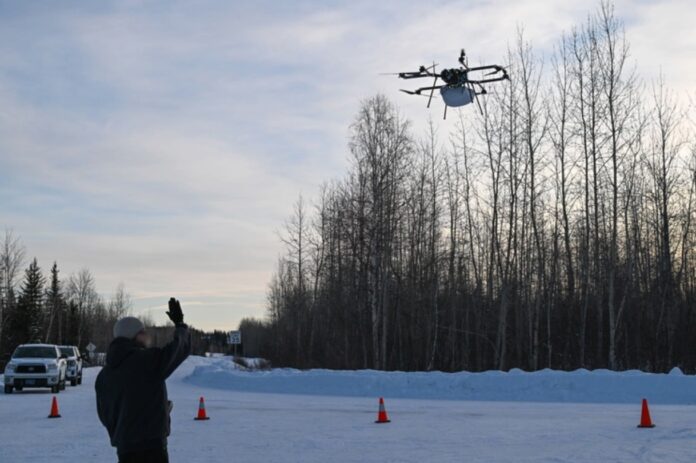
While fighter jets roared overhead during the annual Red Flag exercises at Eielson Air Force Base in late June, a quieter and far less known military trial was underway 20 miles away on a training range near Fort Wainwright, where the Pentagon’s Defense Innovation Unit (DIU) was running live-fire tests of small, long-range attack drones. The tests, according to Defense News, fell well short of expectations.
The purpose of the exercise was to put inexpensive, expendable drones through their paces in a simulated combat environment. The drones were challenged to strike targets while simultaneously being under electronic attack, including attempts to jam their signals. The exercise produced a string of crashes, with some drones slamming into hillsides and erupting in flames, Defense News reported, with photos of the fiery crashes.
The DIU, a Pentagon office tasked with bringing commercial technology into military use, had selected a group of companies to showcase their drone prototypes as part of a broader push to also strengthen the US drone manufacturing industry.
Speaking to Defense News, Trent Emeneker, who leads several DIU autonomy projects, said the exercise highlighted the uncomfortable reality that the US military’s drone capabilities have fallen behind faster-moving global competitors.
These trials come as the Pentagon puts more focus on drone warfare, driven in part by lessons from Ukraine, where drones have played a central role on the battlefield. Military leaders, including Defense Sec. Pete Hegseth, have made no secret of their intent to close the gap and expand America’s use of autonomous systems.
In a sign of that urgency, Hegseth issued a memo on July 10, directing a wide range of reforms to how the services buy small drones, according to Defense News. The changes are meant to cut through procurement bureaucracy and give ground units more freedom to test and buy drones directly from the commercial market.
The Trump Administration has also pushed for more domestic drone production and the removal of policy barriers that have slowed the Pentagon’s ability to field these systems.
The sketchy performance of the drones in Alaska shows both the promise and the pitfalls of the Pentagon’s modernization efforts. Inexpensive drones could transform the battlefield—but only if the military can overcome the very system that too often keeps new technology grounded.
And explain to me whay we are so far behind in this area? Previous andministration completely dropped the ball. And to be quite frank, the one before that.
I,m guessing our young military will take to drones as ducks take to water!
Watching the “Youts” play with their games and such, (A complete mystery to this old late in his 80’s gizzer) show at every level brilliance when it comes to these contraptions, Heck, my knowledge on this stuff is as though my mussel loading mind has no conception of the vast ability of the Ukraine’s drone operators to pinpoint the targets (Same with the Isrial ability to put a drone in through a specific window, 1500 miles away!!!)
Scary as I stated, to an old fellow.
Cheers to the lads and Ladies who master these military apps for drones.
How many of the Interior’s fires were started by DOD drones. Folks suffered with the smoke for weeks.
It DOES suck that our military is so deficient in this arena. We’ve all seen it coming since the first Terminator movie.
It just confirms how unprepared our military is for actual serious ground combat against not even a peer potential enemy. The Russians use fiber optic cable variants which are impervious to any EW defense. And they build industrial quantities at a fast pace that we are currently completely unable to compete with, if we even had any combat capable models.
The Pentagon is the largest example in our federal government of a bloated, inefficient, corrupt partnership between private for profit MIC corporations and the largest government agency. Otherwise known as corporate socialism, in Italy during the 1940s it was called fascism.
The Trump Administration seriously needs to end the multiple wars, conflicts and preparations for starting a war in the Pacific, and live up to his promises to end this none sense. Bring our military home, secure our border and work on building a viable military for homeland defense.